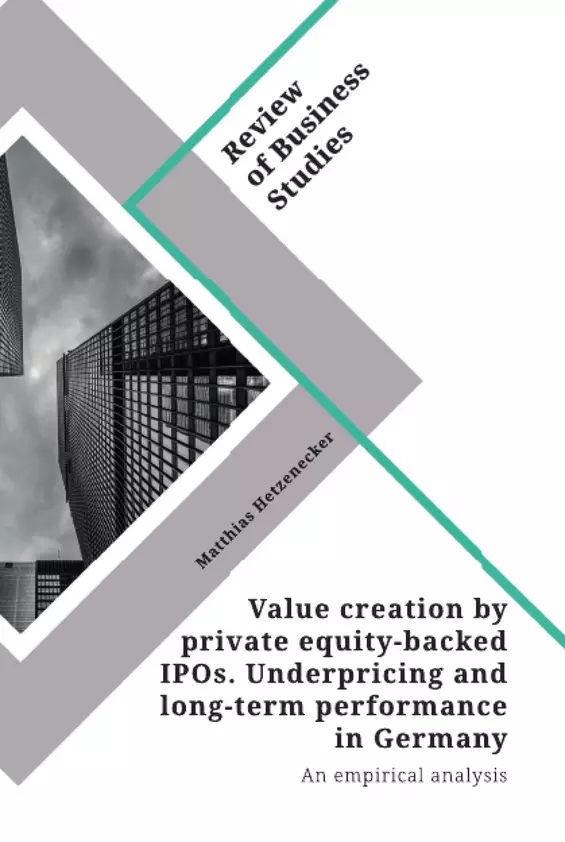This paper examines value creation by private equity-backed IPOs. It gives detailed insights on a mostly US-based research topic analyzing 134 German IPOs from 2002 to 2018, of which 49 were identified as PE-backed, and contributes empirical evidence on the discussion of private equity value creation.
The empirical results provide detailed information on whether private equity financing can be a suitable financing source for companies by comparing and analyzing the performance differences between IPOs of companies with and without private equity sponsors. Furthermore, the paper provides empirical evidence on the IPO phenomena of underpricing and negative long-term performance for Germany, differentiating itself from former studies in terms of a broader time horizon and an extensive return calculation methodology.
Since the locust swarms debate initiated by SPD politician Franz Müntefering, private equity investors have had to struggle with an extremely bad reputation in Germany. Unpopular measures such as company divestures or mass redundancies to achieve set turnover and return targets reinforce the negative image of financial investors. Accordingly, investor and business magnate Warren Buffet criticized that businesses under private equity control become a piece of merchandise.
Nonetheless, the private equity industry continues to boom, reaching new records in terms of global business volume and transactions. Under these circumstances and new evolving discussions, it is essential to take a close look at the business model of private equity firms and to analyze potential short- and long-term value creation in their portfolio companies.
Inhaltsverzeichnis (Table of Contents)
- Introduction
- Growing importance of private equity
- Problem statement and objectives
- Delimitations
- Structure
- Private equity business model
- Definition of terms
- Value chain of a private equity process
- IPO as an exit strategy
- Private equity landscape in Germany
- Theoretical background of IPO phenomena
- Underpricing
- Empirical findings on underpricing
- Explanatory approaches for underpricing
- Long-term aftermarket performance
- Empirical findings on aftermarket performance
- Explanatory approaches for negative aftermarket performance
- Empirical strategy
- Data overview
- Data collection
- Sample selection
- Sample characteristics
- Methodology
- Underpricing methodology
- Long-term performance methodology
- Results and analysis
- Underpricing results
- Long-term performance results
- Conclusion
Zielsetzung und Themenschwerpunkte (Objectives and Key Themes)
This bachelor thesis investigates the value creation of private equity-backed Initial Public Offerings (IPOs) in Germany. The primary aim is to analyze the underpricing phenomenon and its impact on long-term performance in the German market. This research utilizes empirical data and statistical methods to gain insights into the dynamics of private equity exits through IPOs.
- Underpricing of private equity-backed IPOs
- Long-term performance of private equity-backed IPOs
- Impact of private equity involvement on IPO outcomes
- Factors influencing underpricing and long-term performance
- Comparison of private equity-backed IPOs with non-sponsor-backed IPOs
Zusammenfassung der Kapitel (Chapter Summaries)
- Introduction: This chapter introduces the growing importance of private equity in the global economy and outlines the specific problem statement and objectives of the thesis. It also defines the scope of the research and presents the structure of the thesis.
- Private equity business model: This chapter discusses the definition of private equity and its investment strategies. It delves into the value chain of a typical private equity process, highlighting the role of IPOs as an exit strategy. Finally, it provides an overview of the private equity landscape in Germany.
- Theoretical background of IPO phenomena: This chapter explores the theoretical foundations of IPO underpricing and long-term aftermarket performance. It examines empirical findings on underpricing and presents different explanatory approaches, including information asymmetry, signaling, and market microstructure. It also investigates the theoretical perspectives on long-term performance, particularly the potential for negative aftermarket performance and its underlying explanations.
- Empirical strategy: This chapter details the empirical approach employed in the research. It outlines the data overview, including the data collection process, sample selection criteria, and characteristics of the sample. This chapter also explains the methodologies utilized for analyzing underpricing and long-term performance, outlining the specific statistical methods and models employed.
Schlüsselwörter (Keywords)
This research focuses on the following keywords: private equity, IPOs, underpricing, long-term performance, German market, empirical analysis, value creation, exit strategy, information asymmetry, signaling, market microstructure, buy-and-hold abnormal returns, cumulative abnormal returns.
- Quote paper
- Matthias Hetzenecker (Author), 2019, Value creation by private equity-backed IPOs. Underpricing and long-term performance in Germany, Munich, GRIN Verlag, https://www.grin.com/document/958269



